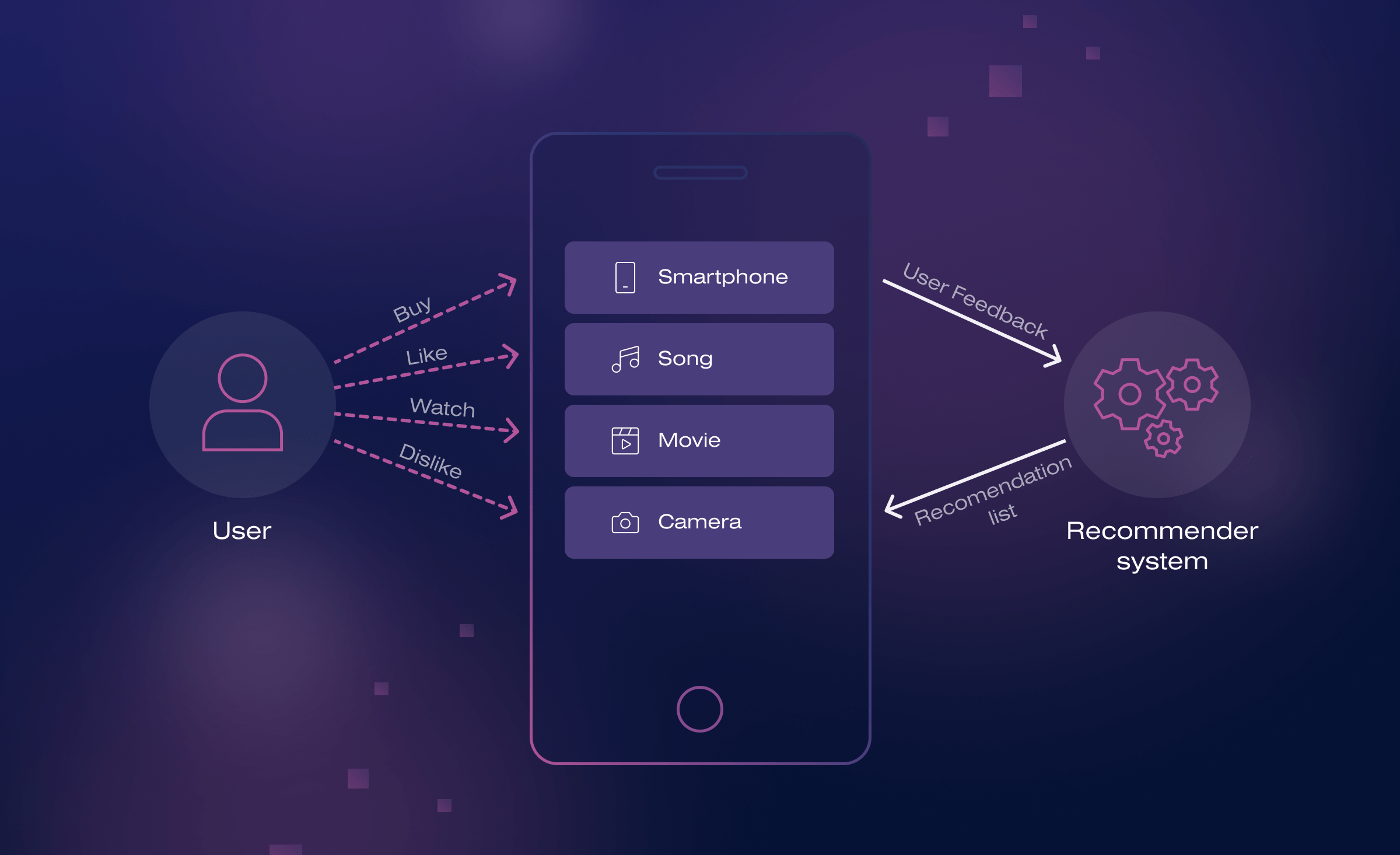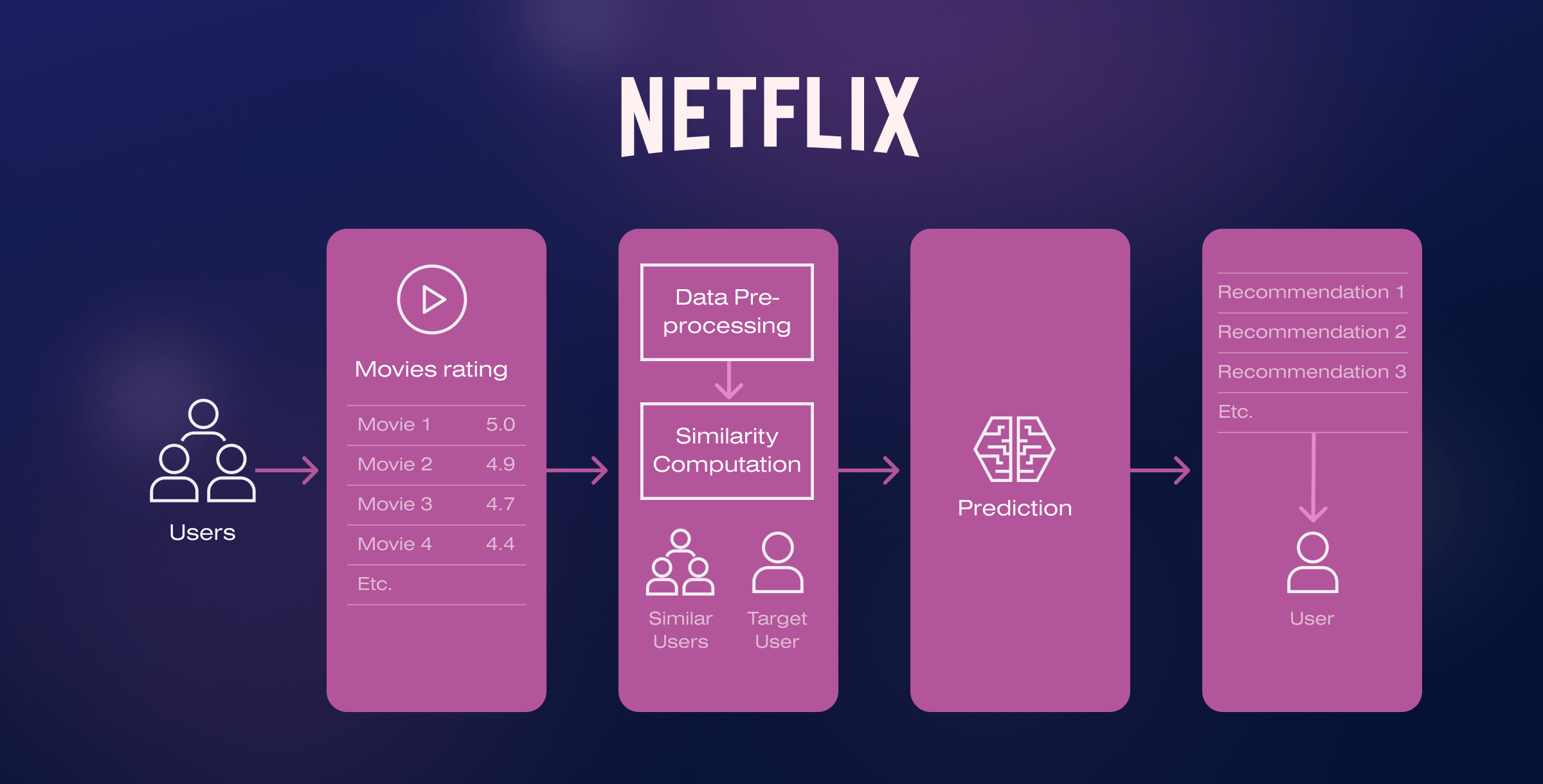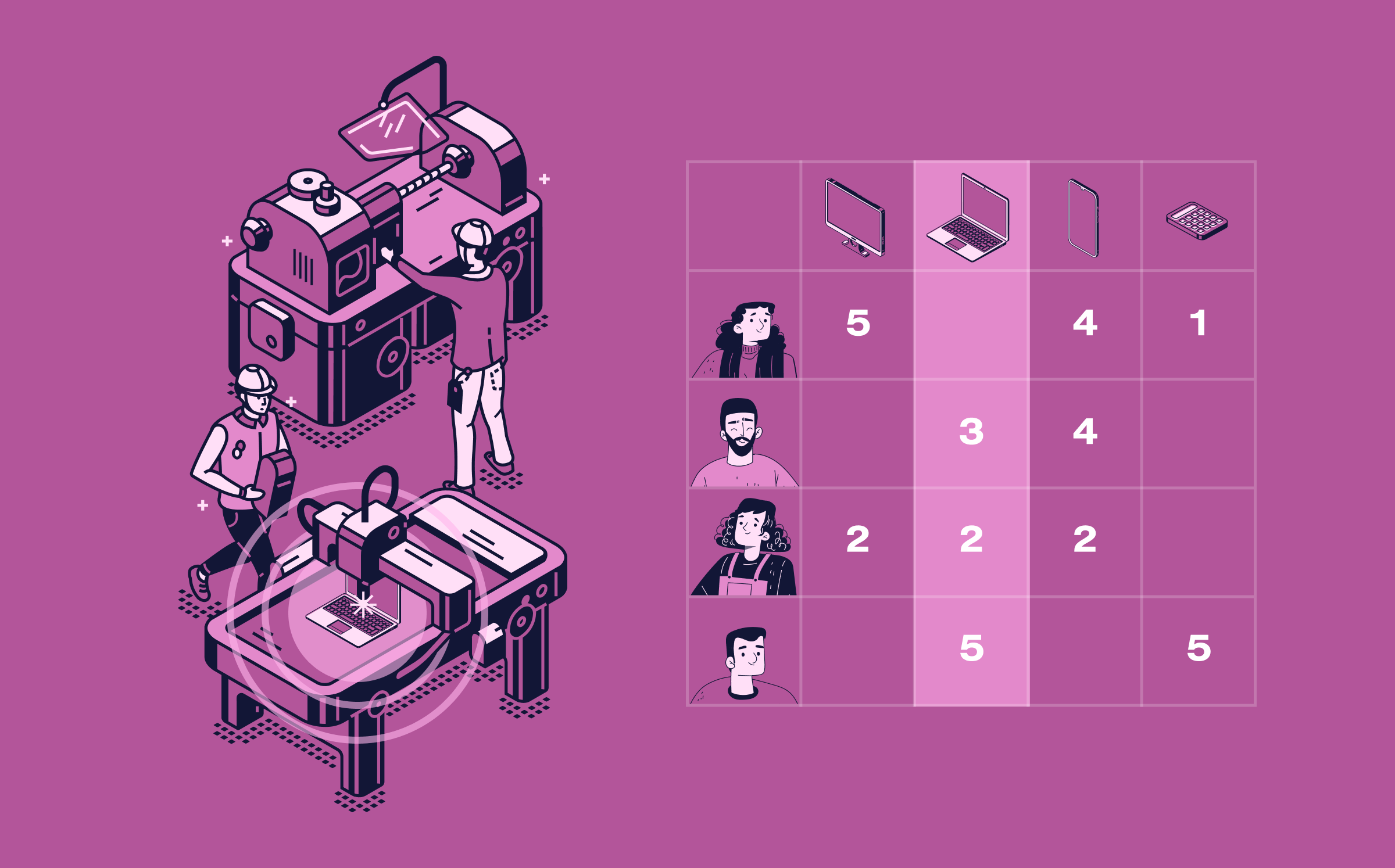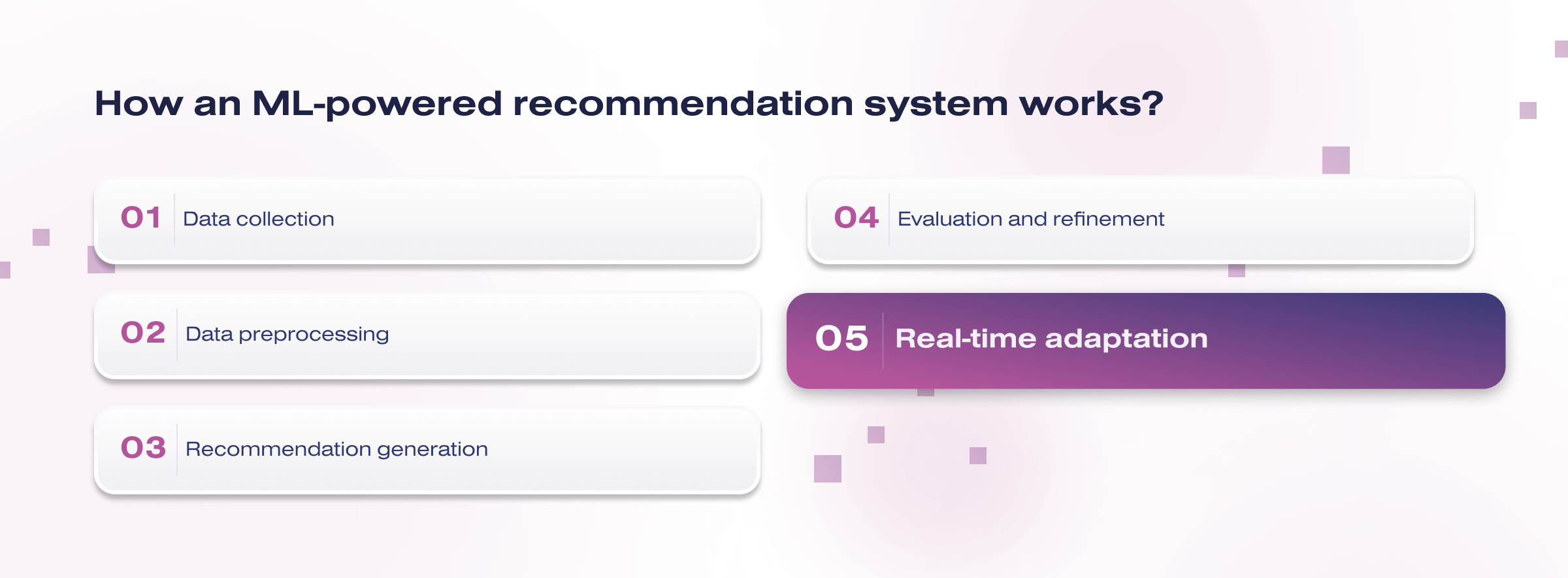Recommendations are used in different businesses. Online stores offer product selections in sections “You might be interested in”. Music and video streaming sites use recommendations to put together a playlist for the day or recommend a movie for the evening. Media shows content the user might like. The recommendation engine market is expected to reach USD 15.13 billion by 2026, valued at USD 2.12 billion in 2020. It is a powerful tool in the right hands.
This article will discuss types of recommendation systems, how ML-powered recommendation systems work, and the pros and cons of recommendation systems.
Key points
What is a recommendation system?

A recommendation system is an information filtering technology that suggests items or content of interest to users based on their preferences, past behavior, or similarity to other users. Its primary goal is to assist users in discovering relevant items or content they may not have encountered otherwise. Recommendation systems are widely used in various domains, including e-commerce, entertainment, social media, and news.
When people buy something in an online store, they notice a “Recommended” section. And the more time they spend reviewing products, the better the recommendations become.
While people are examining the assortment, a special algorithm collects a dossier: what colors and models a person like, what he or she buys, and what he or she removes from the shopping cart. The program finds similar products and shows them to the person first, as if the store only had his or her favorite things in its assortment.
Types of recommendation systems

Imagine you need to recommend a movie to someone. What would you base it on? You might recommend something you like to a friend with much in common. But you’re not likely to suggest “Dexter” to your eight-year-old sister. Both tastes and needs will obviously be different.
The logic of recommendation systems can be different, too:
- Content-based filtering
- Collaborative filtering
- Knowledge-based filtering
- Hybrid filtering
Let’s consider each type in more detail.
Content-based filtering
Have you seen a zombie horror movie? The content-based recommendation system will recommend 25 more. Are you always listening to Queen? Here’s a playlist of rock music from the seventies. It seems like a foolproof approach. But no.
Let’s say you bought a couch. It’s a big, expensive purchase. Most people don’t come looking for a new couch every month. The store is clearly at a loss if the recommendation system advises you to buy 15 more sofas. But advertising systems like Google Ads do not know about the fact of purchase, so for a long time will be throwing all sorts of sofas at you. That is, it will filter advertising based on the content.
Collaborative filtering
What should an online furniture store do in such a situation? The approach is simple – you can track the history of the shopping carts of all buyers of sofas. It turns out that after a couple of months, many people buy tools and sponges for cleaning furniture, some accessories, slipcovers, and capes. To recommend them to the client means to make his or her life easier and, at the same time to make money. But even this approach is not universal.
Knowledge-based filtering
If the site sells houses or cars, the recommendation system can’t rely on other users’ reviews: purchases are piecemeal and rare, meaning there is too little information and no statistical significance. But you want the user to buy his or her dream house from you and not from competitors, don’t you?
In this case, you can add filters: house in the city or the countryside, number of floors and square meters, and wall material. Afterward, the recommendation system selects the most suitable houses from the catalog.
This type of recommendation system is accurate: the user is shown exactly what he or she wants to see. But knowledge-based filtering algorithms are more difficult to think through because the search parameters can be very many.
Hybrid filtering
Hybrid recommendation systems combine different approaches. This way, you can eliminate most of the disadvantages of other recommendation systems. For example, some online clothing stores show items in their recommendations that are similar to the ones person has already seen, as well as those that users with similar tastes have bought. That is, content-based filtering and collaborative filtering are activated simultaneously.
How does the Netflix recommendation system work?

Netflix’s Cinematch recommendation system is one of the most sophisticated in the world. Netflix doesn’t reveal all the details of its machine-learning model, but the basic principles are known.
When you sign up, you’re asked to specify a few favorite movies and TV shows. A feed is generated based on them, which will adjust to your tastes. With likes and dislikes, you can adjust it and add your favorite movies to your playlist.
Netflix wants to know everything about you: what you watch, what you watch before and after a particular show, what time of day you use the service, and how much time you spend on it. The algorithm takes into account your age, gender, and geographic location.
Experts first review every video on Netflix. They manually label and tag the content, describing what the viewer will see on the screen. Users sometimes search for very specific things like “British zombie comedy”, and Netflix can produce relevant content even for such complex queries.
The video service uses movie and user data to estimate the most important information. For example, what influences your tastes more today: what you watched a year ago or a week ago? Usually, the fresher the data, the better. However, Christmas comedies will prove more relevant if it’s the end of December and New Year’s Eve. But only for countries with Christian traditions.
Cinematch looks at both explicit and implicit sources of information. If you’re adding a series to your favorites, it means you’re interested in it. But if you’ve watched three seasons of a show in two days and haven’t added it to your favorites, that’s a good sign, too.
The machine learning algorithm analyzes not only each user but also groups (segments) of users with similar tastes. Netflix has more than 2,000 such interest segments. As a result, even what other people in your segment have watched affects recommendations.
Pros and cons of recommendation systems

Recommendation systems bring obvious benefits to owners of online stores, services, and applications. They show the users exactly what they are interested in and generate revenue.
But there are also disadvantages. People get used to the cues of the recommendation system in the choice of books, movies, and music. They lose the incentive to explore new, unfamiliar genres because they basically like everything the system offers.
The problem of news consumption and smart feeds in social networks is particularly acute. Because here we are talking not so much about entertainment but rather about shaping the worldview.
For example, a racist or a conspiracy theorist who believes in reptiloids will be dominated by material supporting his or her viewpoint. This means that the chances of learning about quality alternative sources tend to be zero, and this person will only be further reinforced in his or her opinion.
How do ML-powered recommendation systems work?

Machine learning (ML) is used for prediction and forecasting, classification and categorization, pattern recognition, fraud detection, and more. ML-powered recommendation systems analyze large amounts of data to identify patterns, similarities, and preferences. Here is a general overview of how an ML-powered recommendation system works:
- Data collection: The system collects user data, including historical interactions, preferences, ratings, purchase history, and demographic information.
- Data preprocessing. The collected data undergoes preprocessing to clean and transform it into a suitable format for analysis. This step may involve handling missing values, removing outliers, normalizing data, or encoding categorical variables.
- Recommendation generation. For a given user, the system may identify similar users or items based on historical data and use this information to make predictions about the user’s preferences. The recommendations can be ranked or scored based on predicted user preferences or similarity metrics.
- Evaluation and refinement. The performance of the recommendation system is evaluated using appropriate metrics, such as precision, recall, or user satisfaction. Feedback from users, such as explicit ratings or implicit feedback, is used to refine and improve the recommendations over time.
- Real-time adaptation. ML-powered recommendation systems can adapt to changing user preferences or item availability in real-time. They continuously update their models based on new data and adjust recommendations accordingly.
It’s important to note that the different techniques and algorithms can be combined, and additional steps, such as privacy protection or ethical considerations, can be incorporated to ensure effective recommendation systems.
How SoloWay Tech can help you implement recommendation systems

SoloWay Tech can assist you in implementing recommendation systems in several ways:
- Expertise and consultation. We have a team of experts with deep knowledge and experience in recommendation systems. We can provide consultation services to understand your specific needs, analyze your data, and recommend the most suitable approaches and algorithms for your e-commerce platform.
- Recommendation system development. We can help you with data analysis and preprocessing tasks required for building recommendation systems. This includes cleaning and preparing your data, handling missing values, transforming data into suitable formats, and extracting relevant features. We can assist in selecting the appropriate recommendation algorithms based on your requirements. Our team can develop and customize recommendation algorithms such as collaborative filtering, content-based filtering, hybrid methods, or advanced deep-learning models tailored to your specific business needs.
- Recommendation system integration. If you already have a developed recommendation system, we can help you integrate it into your e-commerce infrastructure. Our developers can guide integrating the system with your website, mobile apps, or other relevant platforms, ensuring smooth operation and compatibility with your existing technologies.
By leveraging our expertise and services, you can streamline the implementation of recommendation systems in your e-commerce platform, ensuring personalized user experiences and driving business growth.
Conclusion
A recommendation system is needed for businesses with a large selection of products and a user interaction history with those products. These two attributes are enough to think about implementing a simple recommendation algorithm.





